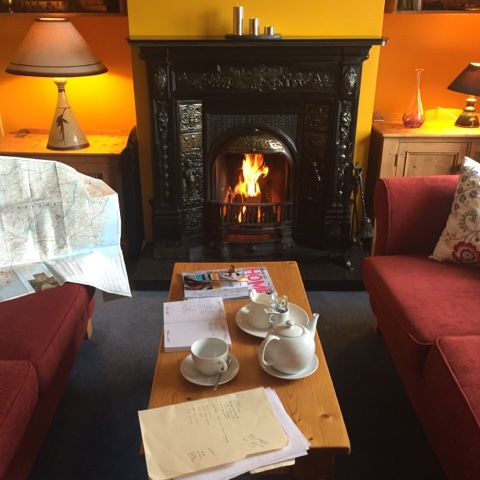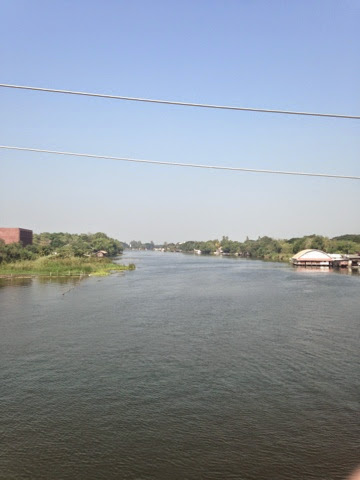After saying goodbye to my traveling companion, who headed back to Dublin by train to catch a flight back home, I was westward bound. I'll admit that I was angst-ing a bit about the driving, but I soon found my confidence and blended in pretty well with the other Irish drivers. (Well, there was one Irishman who took great issue with the way I handled myself in one of the roundabouts, but beyond that, I think I did ok.) The roundabouts are a very big thing in Ireland. They are incredibly efficient, and I wonder why we don't use them more in the US.
My destination was the Dingle Peninsula, the farthest point west in Ireland on the Atlantic coast. I was looking forward to my stay at Gorman's Clifftop House, a more traditional B&B with a small restaurant. En route, I stopped at the Killerney National Park, home of one of Ireland's most beautiful grand homes. I skipped the house and concentrated on the formal gardens and the nearby waterfall. I was anxious to get in some exercise so that I could work off all of the food. The weather cooperated and the gardens were spectacular.
Back on the road, but not before taking a quick cocktail making class in Killerney, home of Ireland's most complete collection of whiskeys. I was more interested in learning about their sourcing of bitters, something that is trending local in the US. Ironically, the bitters and the whiskey were sourced from the US.
The sun was just beginning to set as I drove through the windswept farmland dotted with modest, snug homes with their picturesque stone walls featuring astonishing views of the Atlantic.
The house was cozy and Sheelagh, the proprietor, had a fire going in the living room, and showed me my lovely room with a beautiful ocean view. I joined the other guests, a family of four, in front of the heath fire and drank a pot of tea. Dinner was cooked and served by Sheelagh herself--a gorgeously baked organic chicken with roasted vegetables. Portion sizes in Ireland have tended to be sized for a lumberjack, and as much as I wanted to partake, I had to pass on dessert--a homemade pie.
In many ways, this in my mind was the stereotypical Irish experience and I intended to relax into it, freeing myself of any obligations to see or do anything over the next couple of days. The next morning, after a hearty Irish breakfast, I hiked along the clifftop as the waves crashed into the rocks beneath me. I marveled at the public access, something that would not likely occur in the US, as the farmland fence lines, sometimes nothing more than piled up mud, provided a generous buffer along the shoreline. Sheelagh later related that this is common in this part of Ireland. In fact, there was once a road along that ridge. It would seem that Ireland is not immune from ravages of storms and shoreline degradation, and I was actually shocked to learn how much degradation had occurred over the past 100 years.
Sheelagh had suggested that I try a seaweed bath at the nearby SPA Atlantach, and I jumped at the chance. Fortunately, despite being off season, Christiana was able to accommodate me. I was reminded of my flower bath in Peru. This bath, of course, took place indoors, but it was no less magical as the room was darkened and featured the soothing sounds of ocean waves. The seaweed, extremely slippery to the touch, had been freshly harvested from the beach. Later, I would see plenty of that very same seaweed on my beach walk with Sheelagh and her lively friend Theresa (and Theresa's small dog "Cheetcha"). The salt water was hot and buoyant and after my allotted 25 minutes, my inner mermaid was well satisfied. Christiana had informed me that the seaweed would remove toxins from my body and I felt both tingly and limp at the same time. Christiana then gave me a lovely massage and every tired muscle in my body felt renewed.
My last night in Dingle was spent with the Dingle Cooking School. The class, North African Cuisine, had nothing to do with Ireland, of course, but I was attracted to having a group meal experience, meeting people, and cooking is always fun. I arrived at 6:30 pm for the class. As is customary in Ireland, we started off with cups of tea . The evening's agenda was ambitious: 10 complex dishes to be cooked during our time together.
We started off with the obligatory knife wielding demonstration, something I have yet to master. Then, on to cutting onions and chopping vegetables. I had a very busy beaver next to me who was on to the tomatoes (3rd in line) before I could finish my onions. I was determined to nail down my chopping technique. Tears were flowing as I chopped away--I have never learned the secret to get around that. Once the lamb tajine was assembled, Mike, our fearless leader and the Founder of the school, mentioned that the tajine would need about 2.5 hours. Yikes. I put my appetite in the parking lot and rolled up my sleeves. At some point, I needed to use the bathroom. We were well into the class, hours, at this point, and surprise, surprise! My mascara had ascended to the tops of my cheekbones (I do not feature high cheekbones)! Nothing to do but laugh.
We finally sat down for an incredibly delicious meal at 10 pm. Mike, as it turns out, is a real leader of the food movement in Ireland, and I learned about the food festival, an annual event attracting over 10,000 people per year to Dingle. All in all, it was a great evening and I managed to tackle the winding Irish roads at night as I ascended the mountain to my snug cliff side home for one last night.































































